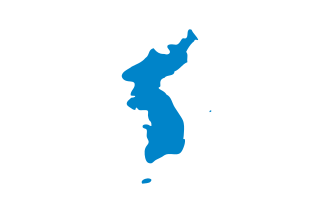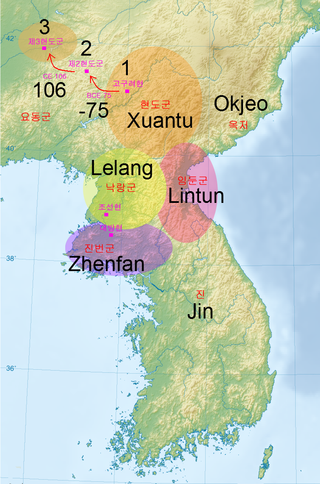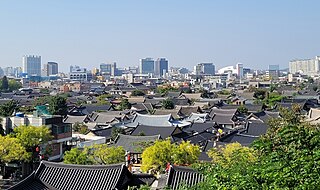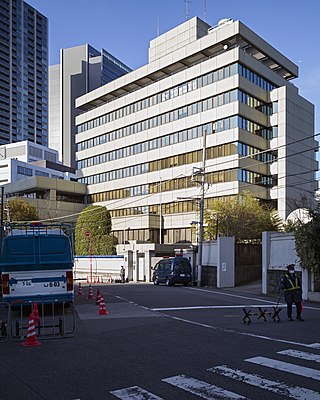
Korea is a peninsular region in East Asia consisting of the Korean Peninsula, Jeju Island, and smaller islands. Since the end of World War II in 1945, it has been politically divided at or near the 38th parallel; in 1948, two states declared independence, both claiming sovereignty over the entire region: North Korea in its northern half and South Korea in the south, which fought the Korean War from 1950 to 1953. The region is bordered by China to the north and Russia to the northeast, across the Amnok (Yalu) and Duman (Tumen) rivers, and is separated from Japan to the southeast by the Korea Strait.
There are various names of Korea in use today that are all derived from those of ancient Koreanic kingdoms and dynasties. The choice of name often depends on the language, whether the user is referring to either or both modern Korean countries, and even the user's political views on the Korean conflict.

The Lelang Commandery was a commandery of the Han dynasty established after it had conquered Wiman Joseon in 108 BC and lasted until Goguryeo conquered it in 313. The Lelang Commandery extended the rule of the Four Commanderies of Han as far south as the Han River in present-day South Korea. South Korean scholars have described its administrative areas as being limited to the Pyongan and Hwanghae regions, whose southern bounds lie roughly 75 miles north of the Han River.
Wi Man or Wei Man was a Chinese military general and monarch. He was originally a military leader of the Chinese Kingdom of Yan. When king Lu Wan of Yan was defeated by the Han in 195 BCE, Wi Man fled to Gojoseon in north-western Korea and later usurped power from its king in 194 BCE, establishing Wiman Joseon. Recorded in the Records of the Grand Historian and the Book of Han, Wiman was the first ruler in the history of Korea to have been recorded in documents from the same time period.

Joseon, officially Great Joseon State, was a dynastic kingdom of Korea that existed for 505 years. It was founded by Taejo of Joseon in July 1392 and replaced by the Korean Empire in October 1897. The kingdom was founded following the aftermath of the overthrow of Goryeo in what is today the city of Kaesong. Early on, Korea was retitled and the capital was relocated to modern-day Seoul. The kingdom's northernmost borders were expanded to the natural boundaries at the rivers of Amnok and Tuman through the subjugation of the Jurchens.

Jeonju is the capital and largest city of North Jeolla Province, South Korea. It is both urban and rural due to the closeness of Wanju County which almost entirely surrounds Jeonju. It is an important tourist center famous for Korean food, historic buildings, sports activities, and innovative festivals.

Gojoseon, also called Joseon, was the first kingdom on the Korean Peninsula. According to Korean mythology, the kingdom was established by the legendary king Dangun. Gojoseon possessed the most advanced culture in the Korean Peninsula at the time and was an important marker in the progression towards the more centralized states of later periods. The addition of Go, meaning "ancient", is used in historiography to distinguish the kingdom from the Joseon dynasty, founded in 1392 CE.

The Veritable Records of the Joseon Dynasty are state-compiled and published records, called Veritable Records, documenting the reigns of the kings of Joseon. Kept from 1392 to 1865, they comprise 1,893 volumes and are thought to be the longest continual documentation of a single dynasty in the world. The records of the last two monarchs are believed to have been influenced by the Japanese colonial rule and, therefore, their credibility compromised. Excluding the records of the last two kings, the sillok is designated as the 151st national treasure of South Korea and listed in UNESCO's Memory of the World registry.
Jiandao or Chientao, known in Korean as Gando or Kando, is a historical border region along the north bank of the Tumen River in Jilin Province, Northeast China that has a high population of ethnic Koreans. The word "Jiandao", literally "Middle Island", originally referred to a shoal in Tumen River between today's Chuankou Village, Kaishantun in Longjing, Jilin, China and Chongsŏng, Onsong County in North Korea. The island was an important landmark for immigrants from the Korean Peninsula looking for settlements across the river. As the number of immigrants increased, the area covered by the name "Jiandao" gradually changed to reflect the areas of Korean settlement.

Korean nationalism can be viewed in two different contexts. One encompasses various movements throughout history to maintain a Korean cultural identity, history, and ethnicity. This ethnic nationalism was mainly forged in opposition to foreign incursion and rule. The second context encompasses how Korean nationalism changed after the partition in 1945. Today, the former tends to predominate.

Samhan, or Three Han, is the collective name of the Byeonhan, Jinhan, and Mahan confederacies that emerged in the first century BC during the Proto–Three Kingdoms of Korea, or Samhan, period. Located in the central and southern regions of the Korean Peninsula, the Samhan confederacies eventually merged and developed into the Baekje, Gaya, and Silla kingdoms. The name "Samhan" also refers to the Three Kingdoms of Korea.

The Korean independence movement was a series of diplomatic and militant efforts to liberate Korea from Japanese rule. The movement began around the late 19th or early 20th century, and ended with the surrender of Japan in 1945. As independence activism on the peninsula was largely suppressed by Japan, many significant efforts were conducted abroad by the Korean diaspora, as well as by a number of sympathetic non-Koreans.

The General Association of Korean Residents in Japan, abbreviated as Chongryon or Chōsen Sōren, is one of two main organisations for Zainichi Koreans, the other being Mindan. It has close ties to North Korea and functions as North Korea's de facto embassy in Japan, as there are no diplomatic relations between the two countries. The organisation is headquartered in Chiyoda, Tokyo, and there are prefectural and regional head offices and branches throughout Japan.

This is a timeline of Korean history.
A recognizable community of Chinese people in Korea has existed since the 1880s, and are often known as Hwagyo. Over 90% of early Chinese migrants came from Shandong province on the east coast of China. These ethnic Han Chinese residents in Korea often held Republic of China and Korean citizenship. The Republic of China used to govern the entirety of China, but now only governs Taiwan and a minor part of Fujian province. Due to the conflation of Republic of China citizenship with Taiwanese identity in the modern era, these ethnic Chinese people in Korea or Hwagyo are now usually referred to as "Taiwanese". However, in reality most Hwagyo hold little to no ties with Taiwan.

Seoul, the capital of South Korea, has been called by a number of formal and informal names over time. The word seoul was originally a common noun that simply meant "capital city", and was used colloquially to refer to the capital throughout Korean history. Seoul became the official name of the South Korean capital after its liberation from Japan after the Second World War.
Anti-Korean sentiment or Koryophobia describes negative feelings towards Korean people, Korean culture, or the countries, North Korea and/or South Korea.

Some past and recent Koreans have claimed that Tsushima (対馬), a large island in the Korea Strait between the Korean peninsula and the Japanese island of Kyushu, has historically belonged to Korea. The island, which is known as Daemado (대마도) in Korean, has been controlled by Japan since at least the 8th century and is currently not officially claimed in any way by the governments of either South Korea or North Korea. However, some historic Korean governments have claimed that the island is rightfully theirs, and there have also been multiple unofficial attempts to assert a potential Korean claim in modern times.
The Jeonggamnok is a compilation of prophetic works which foretold the downfall of the Korean Yi (Joseon) dynasty and the establishment of a new utopian dynasty by a messianic "True Man" with the surname Jeong (Chŏng). Ideologies expressed in this work inspired many insurrectionist movements or claims of political legitimacy from the Joseon period to the present. The contents were circulated orally and in handwritten manuscripts since the middle of the Joseon period. They were copied and recopied many times and often the copyists updated the text to conform to the latest events and trends. Historical compilations and manuscripts related to Jeonggamnok are stored at Kyujanggak Archive.
The following is a family tree of Korean monarchs.











